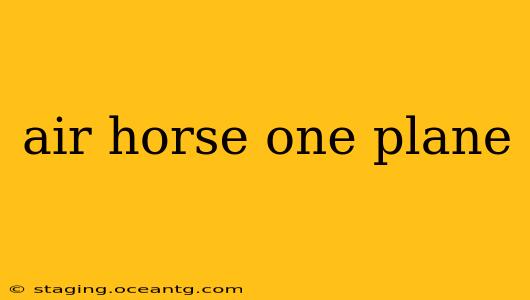The term "Air Horse One" might conjure images of a majestic steed soaring through the skies, but in reality, it's a fascinating and often misunderstood aspect of presidential air travel. There's no official plane designated as "Air Horse One." The term is a playful, unofficial nickname, highlighting the robust backup system in place for the President's primary airborne transportation, Air Force One. This article delves into the intricacies of presidential air travel, exploring the backup plans and the reasons behind the lack of an official "Air Horse One."
What is Air Force One?
Before we delve into the hypothetical "Air Horse One," it's crucial to understand Air Force One's significance. Air Force One isn't a specific aircraft but rather the call sign for any U.S. Air Force aircraft carrying the President of the United States. Typically, these are highly modified Boeing VC-25A aircraft, based on the 747-200B airframe. These flying fortresses are equipped with advanced communication systems, sophisticated security measures, and luxurious accommodations for the President, their staff, and guests. Their capabilities extend far beyond typical commercial airliners.
Why Isn't There an Official "Air Horse One"?
The simple answer is that there's no official need for a second, explicitly named backup plane designated "Air Horse One." The system in place already provides robust redundancy. Instead of a single backup plane, the U.S. government maintains a fleet of aircraft capable of transporting the President, along with a complex logistical network ensuring the President's safe and efficient travel, regardless of circumstances. This approach offers greater flexibility and resilience than a single named backup.
What Happens If Air Force One Encounters Problems?
Several scenarios are planned for if Air Force One encounters mechanical issues or other emergencies. The backup plan involves a complex interplay of:
- Alternative Aircraft: A variety of aircraft, including other large jets within the Air Force fleet, are always on standby, ready to transport the President at a moment's notice. These planes are strategically positioned and prepared for immediate deployment.
- Emergency Landing Sites: Potential emergency landing sites are identified and prepared along the President's flight path, taking into account weather conditions and other factors.
- Communication Systems: Redundant communication systems guarantee uninterrupted contact with the President, even in challenging scenarios.
What Other Aircraft Might Be Used as a Backup?
While there's no "Air Horse One," various aircraft within the presidential fleet and other government resources could be used. This might include other large Air Force jets, potentially even customized civilian aircraft, depending on the specific situation and location. The selection depends on factors like proximity, availability, and the mission's specific needs.
Are There Secret Backup Planes?
Speculation often surrounds secret, undisclosed backup planes. While the precise details of contingency plans are understandably kept confidential for security reasons, the principle is that several backup options exist rather than a single, officially named aircraft. The focus is on flexibility and redundancy to ensure the President's safety and continued operations under any circumstances.
Conclusion: A Redundant System, Not a Single Backup Plane
The absence of "Air Horse One" underscores the sophisticated and robust nature of presidential air travel security. Instead of relying on a single named backup, the system's strength lies in its redundancy and adaptability, ensuring the President's safe and effective transportation under any circumstances. While the term "Air Horse One" is catchy and playful, the real story lies in the intricate, multi-layered system designed to safeguard the President during air travel.
